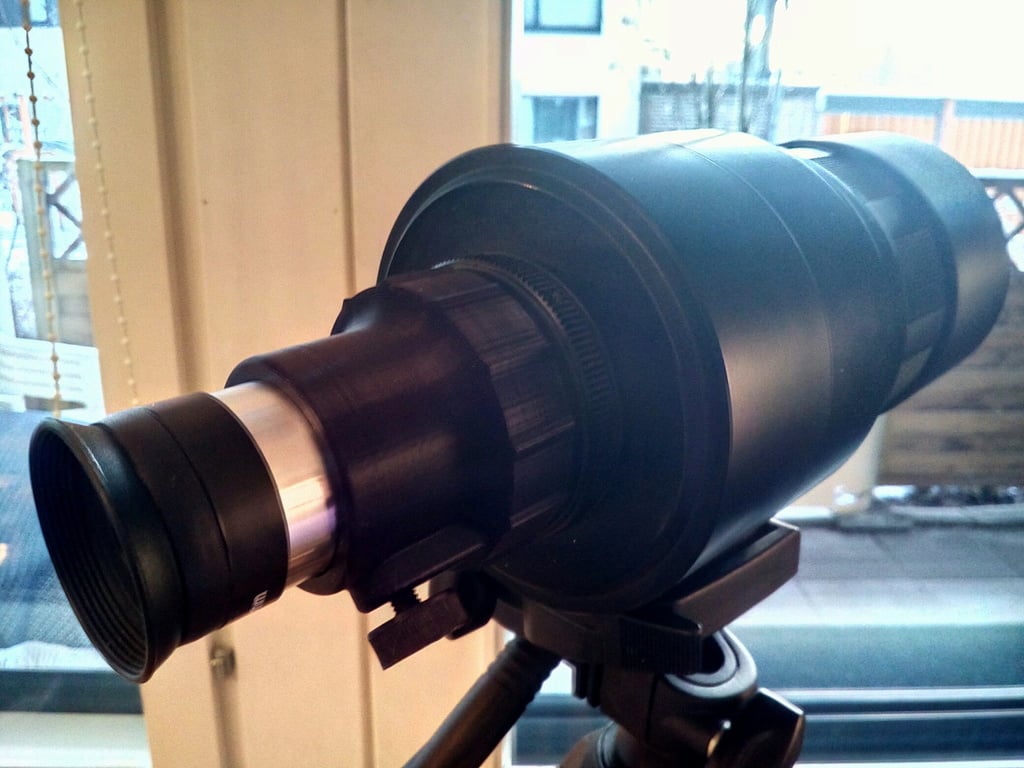
M42 camera lens eyepiece adapter to make telescope
thingiverse
EYEPIECE ADAPTER FOR M42 LENSES - TELESCOPE CONVERSION Many people including myself still own old manual M42 camera lenses which haven´t seen too much use lately. One of mine is a 500mm f/8 telephoto lens which makes a great candidate for building a telescope. Even if you don´t happen to own one, it is pretty easy to find such lenses second hand at very low cost. For a powerful telescope, I recommend an M42 lens with a focal length between 200 and 1000mm, but this adapter will work with any M42 lens. All that needs to be done is to add an eyepiece at the correct distance. So I designed this adapter with a female M42 thread on one end to mount it to the lens and an opening for a 31mm diameter eyepiece on the other end. A focusing mechanism is not really necessary as photo lenses already have a focusing ring which can be used instead. However, the distance of the eyepiece should be adjusted to match the distance scale on the photo lens. Once the correct position is determined (by aiming at infinity), the eyepiece can be locked with a small M5 screw and all focusing can be done by moving the focusing ring. The resulting telescope is best suited for astronomical purposes as the picture is displayed mirrored and upside down. However a simple Zenith mirror element can be added to turn the picture upright which will make terrestrial viewing much easier. An inexpensive but decent quality 10mm eyepiece will result in a 50x magnification factor with the lens I used, which is sufficient for lunar and basic planetary observations. However, it will also work perfectly fine with any M42 lens and the magnification factor will depend on the focal length of the lens used. The actual magnification factor can be calculated by dividing the focal length of the camera lens by the focal length of the eyepiece. In this case 500mm (focal lenth of lens) divided by 10mm (focal length of eyepiece) = 50x magnification. The following additional parts are needed: an eyepiece (see link), an M5 nut and a knurled screw with the same thread if you use the version with the locking mechanism. I didn´t happen to have a suitable M5 knurled screw around for locking the eyepiece, so I decided to print one instead (stl included), which worked surprisingly well, having the additional advantage of not being able to scratch or bend the tube of the eyepiece by overtightening the locking screw. The eyepiece is mostly held by friction so the screw only needs to be tightened lightly to secure its position. Another version of the adapter is also included in the files, where the eyepiece is held by friction only. The threads will work best when all parts are printed in 0.1mm resolution. I used PLA, but PETG or ABS should work equally well. I recommend to use an eyepiece with about 10mm focal length. Eyepieces with shorter focal lengths often have inferior optical quality (except very expensive ones) and are less comfortable to view. I also recommend to use a photo tripod with this telescope, preferrably a sturdy one . Some longer telephoto lenses already have built-in tripod threads which makes mounting the telescope easy. ---------------------------------------- For example the following eyepiece can be used and will work well: http://s.click.aliexpress.com/e/iyzV7yV Optional: Zenith mirror http://s.click.aliexpress.com/e/AEeeAqN ---------------------------------------- PLEASE SHARE YOUR MAKE IF YOU PRINT THIS ITEM. CREATING AND FINALIZING THIS ITEM HAS TAKEN HOURS OF DESIGNING, MODIFICATIONS AND SEVERAL TEST PRINTS TO GET EVERYTHING RIGHT. PLEASE CONSIDER LEAVING A TIP VIA THINGIVERSE IF YOU FIND THIS ITEM USEFUL: http://bit.ly/2szoAhU
With this file you will be able to print M42 camera lens eyepiece adapter to make telescope with your 3D printer. Click on the button and save the file on your computer to work, edit or customize your design. You can also find more 3D designs for printers on M42 camera lens eyepiece adapter to make telescope.
